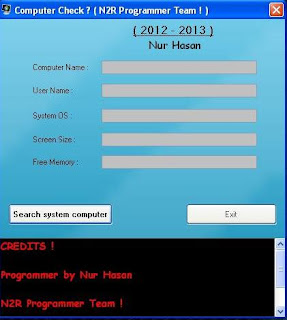Check Computer v 1.0
Check Computer v 1.0

Feature :
- User Name Search
- Screen Size Search
- Free Memory Search
- System OS Search
System Requirements ( Net.Framework 2.0 )

Read More
Desktop Capture v 1.0
Desktop Capture v 1.0
Feature :
- Format ( JPG )
- Full Screen Capture

Read More
How to like every comment or status on your Facebook page
Today
we announce an extension which is probably not one of those functions
that you cannot do without, or you've been looking for some time. Rather
it is one of those things a little 'useless circulating on the web, but
funny, viral, and good to make jokes and have fun with friends on
Facebook.
Let's
talk about an extension available for Google Chrome that allows you to
click simultaneously on all the "like" a page on Facebook .
So
if, for example, were visiting a friend's profile and a status update
there are several comments, simply click on the extent to click "Like"
on all comments.
The extension is called All Like Facebook and
find the Chrome WebStore. Once installed you'll notice the top right
button on a new browser (see image). You just need to click on all I
like to click on the page.
(If you do not work, try first to refresh the page by pressing F5 on your keyboard). Have fun!
Read More
6 Tips to make your Mac Safer
In the wake of Flashback, everybody's asking if Macs are still safe. Here are six easy tips on how to be your own gatekeeper.
The Flashback Trojan went viral last week, infecting an estimated 1 percent of OS X computers worldwide. While the infection rate has subsided since then, that doesn't mean Mac owners should return to complacency.
It doesn't mean that there's cause for panic, either. Here are some common sense, effective tips for safeguarding your Mac against more malware.

Avast for Mac
There are both free and paid options, including Avast (download), Sophos (download), ClamXav (download), Kaspersky (download, trial), and Intego (download, trial).
If you're dead-set against running a full suite, at the very least use a browser tool that will check links to make sure they're safe before you load them. AVG LinkScanner (download) is a good place to start.

Lockdown your Mac's Admin privileges.
You can disable Java by going to the Applications folder then Utilities, and unchecking the Java version boxes under the General tab.

How to deactivate Java on your Mac.
Read More
More than 600 000 Macs system infected with Flashback Botnet
The computer security industry
is buzzing with warnings that more than half a million Macintosh
computers may have been infected with a virus targeting Apple machines.
Dr. Web originally reported Wednesday that 550,000 Macintosh computers were infected by the growing
Mac botnet. But later in the day, Dr. Web malware analyst Sorokin Ivan
announced on Twitter that the number of Macs infected with Flashback
had increased to 600,000, with 274 of those based in Cupertino, Calif.
Dr. Web explained that a system gets infected with the Mac Flashback trojan "after a user is redirected to a bogus site from a compromised resource or via a traffic distribution system." A specific JavaScript code
on the site that contains the virus is then used to load a Java
applet, which is how the malware makes its way onto a user's computer.
This Trojan spreads via infected
web pages and exploits Java vulnerabilities that have been known for
some time, yet Apple didn’t see fit to release a patch until this week
(Java for Mac OS X 10.6 Update 7 and Java for OS X Lion 2012-001).
Macs
have historically been an unappealing hacking target because of their
low market share. Instead, criminals have attacked personal computers
running Microsoft
Corp.’s Windows software, seeking the biggest number of victims for
illicit moneymaking schemes. Windows runs on more than 90 percent of
the world’s desktop computers, according to market researcher Net Applications.
'All the stuff the bad guys have learnt for doing attacks in the PC world is now starting to transition to the Mac world,' McAfee Labs director of threat intelligence Dave Marcus told.
Once installed, the Flashback will inject code into Web browsers and other applications like Skype to harvest passwords and other information from those program's users.Security company F-Secure has published instructions on how to determine whether a Mac is infected with Flashback.
'There
has been a significant increase in Mac malware in the last several
quarters, so what we've seen with the Flashback Trojan isn't
particularly surprising,' Marcus said.'Cybercriminals
will attack any operating system with valuable information, and as the
popularity of Macs increase, so will attacks on the Mac platform.'
Read More
How to unlink Facebook from Skype
Social media services and applications are always trying to make
everything link together for our "convenience." Unfortunately, what's
convenient for some is a nightmare for others, especially in the case of
linking two large social media accounts together.
Linking Skype and Facebook allows you to see wall posts in the Skype
Home window, which can be responded to and liked. But if this is a bit
of information overload after a recent link of the two, unlinking them
can be done in just a few steps on both services. Here's how to get
started:
For Skype:
Step 1: Access the Skype Home window. If you have this turned off by default, you can open the View menu and select Skype Home.
Step 2: Click on the small cog to the far right-hand side and click Disconnect from Facebook.
For Facebook:
Step 1: Head to your Facebook account in a Web browser.
Step 2: Click the down arrow menu in the top right-hand corner of the Web site near your name and select Account Settings.
Step 3: From the menu on the left-hand side, choose
Apps. Then click the X next to Skype and confirm the removal of Skype in
the pop-up window and you're all set.
Your Skype friends list will now only show friends that have been directly added through Skype.
Read More
Recover Lost Files in Hard Disk, Memory Card and USB Drive
What if you have formatted your USB Drive? Or you have deleted an important
file from your system of Pen drive? You can still recover these deleted
files. There is a nice windows tool which is available for free. This
tool is DiskDigger which is able to recover all type of lost documents and files.
DiskDigger is able to recover files from FAT (FAT12, FAT16, FAT32), NTFS, and exFAT partitions.

Download this tool and run in your system. You will see the list of drives available in the system. Select the drive from which you want to recover files. Then click on and next to start recovery process.
While recovering files, you can pause or stop the process at anytime. To recover the file, click on Save. But there is no option to recover all files at once. You need to recover files one by one
Read More






















